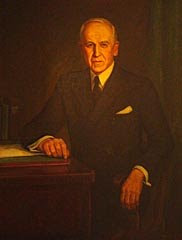HERBERT BROWN MAW
1893–1990
1893–1990

Herbert Brown Maw was born in Ogden, Utah in 1893. At age 11, he went to work to help support his family by selling newspapers on the streets of Salt Lake City and aluminum pans door to door. He also operated an ice cream stand at the Saltair Resort. While working, Maw continued to go to school, attending LDS High School and the University of Utah Law School. During World War I, he served as an LDS chaplain. Following the war, Maw earned a master’s and law degree from Northwestern University. When he returned to Salt Lake City, he taught political science and speech at the University of Utah. He served as Dean of Men at the University from 1928 to 1936.
In 1928 Maw was elected to the state Senate and served there for ten years, four of which he served as Senate President. He was elected governor in 1940, and quickly reorganized the Executive Branch creating fewer departments, which received bipartisan support from the Legislature. With World War II on the horizon, Maw worked hard to attract military installations and industries to Utah. Utah’s location made it ideal for many wartime facilities, which created thousands of jobs and energized Utah’s economy. Maw served his second term as governor during the transitional period from war to peacetime and supported legislation to help veterans return to civilian life and gain access to housing and education. He was particularly dedicated to improving highway systems so that Utah’s scenic attractions would be more accessible. After losing his bid for a third term, Maw retired to private law practice and maintained office hours well into his nineties, handling many pro bono cases for the poor.
ARTIST
Lee Greene Richards (1878–1950) was a well-known Utah artist who studied with J.T. Harwood and trained in France. In 1904, he received honorable mention at the Paris Salon, making him the first Utah painter to receive this honor. Richards’ artwork can be seen throughout the Capitol with murals in both the rotunda and Senate chamber as well as portraits of Utah governors Spry and Mabey.


 Charles Rendell Mabey was born in Bountiful, Utah in 1877. He attended the University of Utah and worked for ten years as a teacher and administrator. Mabey served in the Utah National Guard during the Spanish-American War and received a citation for gallantry.
Charles Rendell Mabey was born in Bountiful, Utah in 1877. He attended the University of Utah and worked for ten years as a teacher and administrator. Mabey served in the Utah National Guard during the Spanish-American War and received a citation for gallantry.




